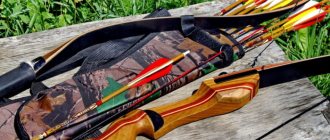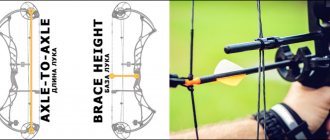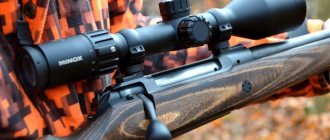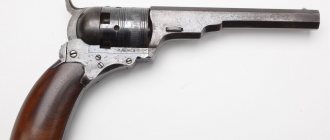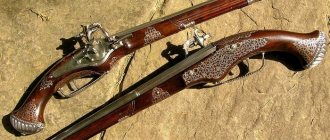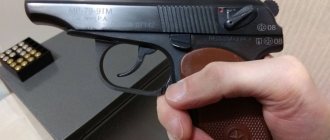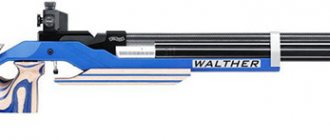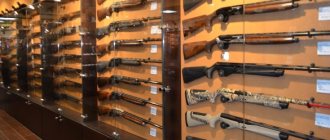In ancient times, bows were the main weapon of many armies around the world, mainly the Greeks and Romans. They were popular for a short period of time. With the advent of firearms, they were decommissioned. But interest in them has revived among people relatively recently. People began to become interested in them en masse in the late 1990s and early 2000s, when films about hobbits appeared on television screens. Also, after the release of the book about Robin Hood, many also became interested in such ancient weapons.
In this article we will analyze the main types of these weapons, tell you the advantages and disadvantages, describe the characteristics, and also make a rating of the best sports and hunting bows.
Types of bows
The design, which was called the bow, developed and improved over several millennia. Thanks to this progress and constant development, 3 types of bows were formed.
Traditional
Peoples used it until they invented different types of firearms. Simply put, these are bows of the autochthonous peoples of Asia and Europe (that is, primitive people).
They are made from leather and wood. Each bow is special and has its own unique characteristics, which is why it is not mass produced. Entire years of training will be needed to become a master and thoroughly master this weapon.
Classic
Another name is “Olympic” because they are used primarily for sports competitions. Most bows of this type have a recurve shape. By bending the elastic branches, the energy for the shot is accumulated.
The classic design allows you to accumulate 2 times more energy than the traditional one. The Huns were the first to use recurve bows. After this equipment began to be equipped with additional attributes that increased shooting accuracy to maximum values, they began to be used for sports competitions. Additional elements included:
- vibration dampers;
- shelves for arrows;
- balancers;
- sights.
A shelf for holding arrows has become an essential attribute of classic bows. This device prevents the arrow from hitting the handle when it leaves the string. Thus, it was possible to replace natural feathers with hard stabilizers, which allow you to increase shooting accuracy to the maximum, while applying little effort.
The results will not be immediately noticeable, since it is very difficult to tighten the bowstring. After hard training, your results will gradually begin to improve.
Block
They first appeared in 1969 in the USA. The design increases the forces applied to the running end. This happens thanks to special blocks called pulley blocks. The more of them installed, the stronger the shot will be. The energy of the throw is accumulated mainly in the cable system, and not due to the force made. A special feature of these bows is the “wall” effect – force release when the maximum draw point is reached. It reaches 80 percent. For example, if a bow has a draw weight of 27 kg, then holding the string will require a force of 4 kg.
Is this kind of hunting allowed or not?
Many hunters are interested in the question, is bow hunting legal? Modern legislation currently practically does not regulate this. That is, it turns out that bow hunting is not prohibited, but at the same time there are some restrictions.
For example, a bow with a draw weight of no more than 27 kg will not be considered a weapon. This fact is confirmed by documents that the owner can receive at the time of purchase. In addition, under no circumstances should a sports bow be used behind the sports field. This is prohibited by law.
However, the law does not clearly stipulate that this fishery requires any permission. In addition, bow hunting cannot be carried out during research work, but it is almost impossible to prove the fact that a person was simply hunting and not studying forest inhabitants.
From this we can conclude that it is possible to hunt with a bow on the territory of our country. In addition, lately there has been a lot of talk about classifying this type of weapon as a hunting weapon.
Efficiency
Classic bows do not have much penetrating power. During the descent of the bowstring, they give all the force to the arrow. Such devices fly at a speed of no more than 50 meters per second. Although they do not have great penetrating power, thanks to this mechanism, the rate of fire can be increased.
Block ones accelerate slowly, but their maximum speed reaches 90 meters per second. They are often classified as hunting weapons because they have a low rate of fire, but the accuracy and accuracy of hits is virtually identical to that of firearms.
The average price is approximately 11 thousand rubles.
Shooting technique
Before you start shooting, you need to choose the right weapon taking into account your parameters and learn the correct stance.
Before archery
It is necessary to straighten your shoulders, straighten your back, slightly tense your abdominal muscles.
- Your feet should be shoulder-width apart, almost parallel to each other.
- The weight distribution between the toe and heel will be 60% to 40%.
- Turn the body slightly towards the target.
The main thing in the stance is to correctly distribute the weight and anchor yourself relative to the ground.
The process of tensioning the bowstring
When choosing the right bow, be sure to try different models for draw weight. For this you need
- Get into a shooter's stance.
- Raise your right arm perpendicular to your body at shoulder level.
- Bend at the elbow and pull the string to the limit.
The optimal stretch can be considered to be one in which the hands do not tremble from excessive tension.
Shooting technology
Equipment elements required during shooting:
- Manufacturing. This is the correct posture for a shooter ready to start shooting. The legs are the support for the whole body and must be motionless. The body acts as a mechanical support for the weapon, therefore it is positioned vertically or slightly tilted forward. The head is turned towards the target, the neck muscles are moderately tense, the teeth are clenched. The bow string should be in contact with the tip of the nose and the middle of the chin, and the hand of the dominant hand should move along the jaw.
Types of production:
- open. The smallest angle between the bow hand and the shoulder line. The right leg is slightly moved forward;
- lateral. The legs are almost parallel to each other. The angle between the bow hand and the shoulder line is greater;
- closed. The right leg is slightly laid back. Has the greatest angle between the arm and the shoulder line.
- Grab. This is the position of the hand holding the bow. There are low, medium and high grips.
- Capture. This is the position of the hand holding the string and arrow. The load on the fingers should be even, the shoulder and forearm should be parallel to the ground, the elbow bent and slightly raised.
- Tension. Occurs due to the muscles of the arms and back. The stretched bowstring is strictly parallel to the shoulders (arcs) of the stationary device. Pulling it with a slant to the side is unacceptable. After the arrow is released, the tension continues, i.e. Do not suddenly release the bowstring.
- Aiming. This is pointing the front sight at the center of the target and holding it until the shot is fired. It is impossible to see objects at different distances equally well, so experienced shooters advise focusing your vision first on the front sight, then on the target.
- Holding your breath. In the interval between the tension of the bowstring and the shot, the breath is held. This is necessary for stability and concentration. The duration of the delay is 10-15 seconds.
- Descent. The bowstring is released from its grip. This must be done with all fingers at the same time.
The correct stance aims at results.
Recoil and vibration
The recoil during archery is quite noticeable, especially for beginners. Occurs as a result of mechanical vibration affecting the shooter’s hand after firing a shot. Since the shooting process obeys physical laws, recoil cannot be avoided. But you can choose a bow with the least amount of vibration.
Conclusion
This article discussed all the features of bows for hunting and sports. Their features and characteristics are described and their advantages and disadvantages are shown. Despite the fact that the bow was popular for quite a long time and was withdrawn from service, interest in this weapon was revived literally 50 years ago.
Now there are 3 main types of bows: Traditional (not mass produced), classic (the most popular) and compound (intended primarily for hunting or sports competitions). The review describes classic and block ones. Among them there is one traditional bow, but it is classified as a classic one.
Thanks to the compiled rating, the buyer will be able to determine which bow to buy for him!
#9 McPherson Monster Chill - Score: 71 out of 100
Techniques and rules for shooting from a revolver and pistol
The latest in Mathews' line of Monsters, this bow has us baffled. If usually Monsters were fast bows, then this one cooled expectations. In general, for its price it should have been better.
Advantages
: Good workmanship and appearance, and Hinton praised it for its balance as well. Quite quiet for the third fastest bow.
Flaws
: The Chill received low scores in most categories, including no stop in stretching. The stretch curve is quite mediocre and gives a vague feeling. Well, it's just not worth the money.
Brief conclusions
: We spent a lot of time trying to understand this bow. The conclusion is that he is a victim of an identity crisis. He's undecided whether to be the hunting type or the sporting type, so he doesn't do either particularly well.
Characteristics
: 30 1/2″ length from axle to axle; 7″ base; weight 3.9 lb.; 80% let-off; 293 fps And, in conclusion:
Arch Basics
The bow is a tool or weapon that has deep connections in human history as well as many cultures. Therefore, there is a wide variety of design and construction elements. In its basic form, the arc consists of a flexible limb known as a pentagram, connected at each end by a string.
Arches were traditionally made of wood and horn, and still can be, but modern arches are also made of fiberglass, plastics and various metals.
The arc works by storing mechanical energy, which the user provides as he pulls the rope back under tension. There are two different drawing methods that divide all arcs into one of two broad categories; Mechanical, not mechanical.
Creation of a shooting complex
The homemade bow for hunting is ready, and you need to decide what to do with the arrows. First of all, the length of the arrow is determined. It is equal to the length of the arm, starting from the shoulder joint and ending with the tip of the shooter’s index finger. The arrow should be smooth, even, straight and have a diameter within 6-8 mm. There are a lot of options for creating arrows, and you won’t be able to find a perfectly flat piece. In any case, you will have to modify the arrow with a knife, plane and sandpaper. A blank of the required size can be found in the forest, cut from a tree branch. In urban conditions, processing of mounting beads has proven itself to be effective, albeit with a lot of time. Many new shooters use bicycle spokes as their first arrows. It is up to the user to invent the feathers and tips on their own, because their creation is a creative approach that depends not only on the author’s imagination, but also on knowledge of physics and aerodynamics. You must always remember that the flight of an arrow depends not only on the efforts of the hunter; the flight is greatly influenced by the feathers.
Arrows and screws
Arrows consist of a rod, usually made of aluminum or carbon fiber, although composite arrows are now becoming increasingly popular. At the top end of the shaft, an arrowhead is attached, and at the other end, a sleeve, usually cut or curved, is connected together with spikes or blades, which are usually made of plastic and placed in a three-blade configuration.
Other configurations can be made, as well as the use of bird feathers, but this usually implies a specific circumstance or situation in which the arrow should behave differently. The stack stabilizes the arrow while it is in the aiming and shooting arc, the stretching motion allows the stabilization to rotate towards the arrow for greater accuracy.
The arrows that are used in non-mechanical arcs are similar to the arrows used in mechanical arcs, which are predominantly made of aluminum or carbon fiber or even a combination of both. However, they generally cannot be interchangeable, as non-mechanical bows release the arrows much more forcefully than the smooth release of a compound bow, and therefore require a stiffer arrow so they don't flex as much during release and flight.
Arrows are made in different weights, axle lengths, and stiffnesses (called tenons) as they must suit the archer's shooting style, preference, draw weight, and draw length.
The arrows used on leaf springs are known as bolts. They consist of a rod with a flat or lunar locking system at the base near the sites and target heads (used for target purposes only as they are not sharp) or broad heads (used for hunting) screwed onto the tip. When it comes to using bolts, always consult the manufacturer's recommendations; However, you can use bolts that are a little heavier and longer, but not smaller, as this may cause the crossbow to malfunction.
